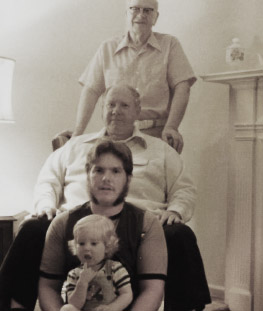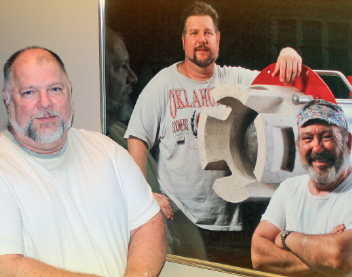Guy Johnson has been intrigued with the way things work since he was just a boy. It’s a curiosity born and nurtured many years back in the creative confines of his grandfather’s basement.
A Mechanical Dance

Four generations of Johnson men, with Guy’s grandfather, Charles Ordway Johnson, pictured at top.
Like most boys do, Guy looked up to his grandfather and spent a lot of formative time in his basement workshop – a space filled with all the wonders to capture a child’s imagination, like car parts, chrome gears and a Japanese rifle from the second World War.
“I was just fascinated by the gears and how they fit together at an angle, and the geometry,” he says. “To me, it was almost like a mechanical dance.”
Of his grandfather, he adds, “Gramps wasn’t real talkative with me. But the few things that he would say, you know, it bore a lot of weight with me. I was very impressionable.”
An innovator with General Motors, his grandfather designed part of the transmission and differential still used in many of today’s vehicles. But Guy’s own path to invention and experimentation all began with a bike.
“My bicycle was made out of nine different bikes because there were a bunch of different parts in the garage,” he says. “And Dad said, if I could make something out of them, I could have it. So I did.”
Fulfilling a Need
As a manufacturing design specialist with John Zink Hamworthy Combustion since 1989, Guy applies that same passion for building, creating and improving upon things to everything he touches in his shop. If a piece of equipment is not working right or efficiently, he’ll design a way to make it better.

As seen in Popular Mechanics, a welder works inside the internal vertical tubing of one of the flares John Zink Hamworthy Combustion produces. Guy plays a critical role in manufacturing process improvement helping to make it possible to build flares like this one.
“There’s some of me everywhere,” he jokes.
He’s also very hands-on – has been since he first started out as a draftsman in 1969. So when he sees a way to make a process better or is asked to find a solution to an existing problem, he rolls up his sleeves and fully commits himself.
A shining example: back when his facility was producing just 10 DBK pilot main bodies a day, he devised a way to improve efficiencies and produce one unit every 48 seconds. To put it in better context, that’s like accomplishing a week’s worth of work in less than an hour.
Technically speaking, he says, “I built a fixture, had the valve on the pipe as a subassembly, and staged the parts and fixture strategically to eliminate unnecessary motion. I used flux-core weld wire, and the weld slag released as the weld cooled, which eliminated spatter clean-up.”
On another occasion, Guy noticed the welders were having trouble using their handheld sub-arc welding units to weld the internal seams of rolled tubes with internal diameters smaller than 24 ¾ inches. So he designed a unit that can weld all the way down to six inches.
“It works pretty well,” he says. “It’s got level sensors for the deflection on the arms that keeps the nozzle at a given distance from the material. I’ve got a brake on the swivel, so you can either set it and let it run straight or release it and let it follow the knife edge for the first pass.”
And while he’s relatively new to using CAD software, he’s not one to shy away from change – it’s part of what keeps him going. He considers himself “an inventor at heart” and believes in finding needs, then fulfilling those needs.
“The needs keep changing,” he says. “And I appreciate that. And the technology keeps changing. So, now that I have access to see what’s out there and see what other people are doing and see what kind of spin I can put on it – that in itself bears its own fascination.”
Feeling Needed
John Zink Hamworthy Combustion’s mission to deliver practical, problem-solving solutions to customer needs is in perfect alignment with Guy’s own innovative spirit.
Headquartered in Tulsa, Oklahoma, the company offers environmental solutions for a variety of industries worldwide, including chemical and hydrocarbon processing, oil and gas exploration and production, marine/offshore, fuel distribution, power/utilities, combined cycle/co-gen, industrial, biofuels/ethanol and solid waste.
Proudly delivering products engineered to order with an environmental focus, John Zink Hamworthy Combustion produces process burners, thermal oxidizers, flares, gas recovery systems, boiler burners, duct burners, vapor control systems, biogas flare systems and specialized burner systems for the offshore and marine sectors.
It’s part of the company’s objective to develop a clean generation of combustion products that address customer challenges while remaining conscious of the environment. Because addressing challenges, whatever they may be, is all in a day’s work for Guy.
And since John Zink Hamworthy Combustion is home to the combustion industry’s largest research and development test centers, he’s regularly put to the test finding unique solutions to the question, “what if?”
Headquartered in Tulsa, Oklahoma, John Zink Hamworthy Combustion develops a number of emissions-control and clean-air systems, seen here, for some of the world’s most demanding industries.
“I enjoy the fact that we have an R&D center here and that a lot of times they’ll reach out and say, ‘What can we do about this?’ or ‘How can we do that?’” he says. “And, ‘I don’t see any way to do this – how do you think we can do it?’ Just the fact that I feel needed … I guess a person has to feel needed.”

In what he calls a “time lapse,” Guy stands next to a photo of himself with a prototype multi-venturi hexaburner that he helped design.
Keeping People Safe
When working with 20,000-pound structures suspended from cranes, safety’s always a concern, and it’s something Guy takes very seriously. So whenever safety issues do arise, they become high priority on his hot list.
Not long ago, a worker injured their hand using a slide hammer while removing details from poured tile, so Guy developed a clever, low-tech fix using materials they already had on hand to aid impact absorption.
“I actually took large cable shrink wrap and I shrink-wrapped the whole thing so that absorption wouldn’t be destroyed from the tile media,” he says. “Anyway, since then, we haven’t had any injuries in that respect.”
Additionally, he took it a step further and designed a pneumatic substitute for the slide hammer, which he made in three different sizes for varying weight requirements. His upgraded version now uses an air hammer to remove tile mold components with little effort.
And regarding those 20,000-pound structures, one of his focal points right now, he’s currently building a fixture to prevent employees from reaching underneath to clean and re-tap the pads. But in the meantime, he’s found an even simpler solution to the problem – 90-degree portable drills that replace any risk to life or limb.
Of the problem-solving side of his job, he says, “I like the challenge. I like being able to use my mind and creativity.”
As much as safety, though, he also values the insights his workers provide and making things better for people – be it family, friends or customers. It feeds his need to experiment and provide real-world solutions for existing problems. And it makes John Zink Hamworthy Combustion that much better of a place to work.
“I get to be on the ground floor of a lot of different procedures of how we manufacture things. I thank God for all he has given me. Without him, I would be nothing.”
Read more about John Zink Hamworthy Combustion in the October 2015 Popular Mechanics write-up on Koch Industries..